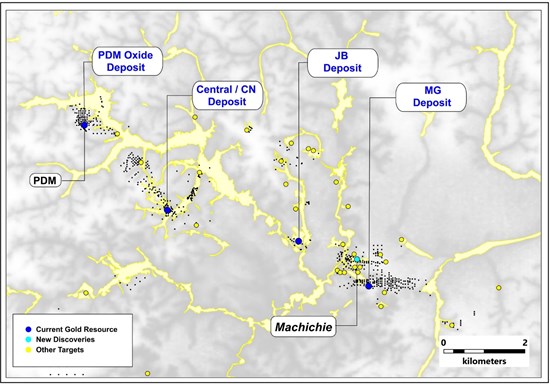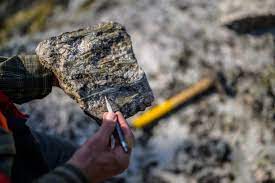News Releases
Cabral Gold Announces New Mineral Resource Estimate for the Cuiú Cuiú Project, Brazil
Vancouver, British Columbia–(Newsfile Corp. – September 30, 2022) – Cabral Gold Inc. (TSXV: CBR) (OTC Pink: CBGZF) ("Cabral" or the "Company") is pleased…

Vancouver, British Columbia–(Newsfile Corp. – September 30, 2022) – Cabral Gold Inc. (TSXV: CBR) (OTC Pink: CBGZF) (“Cabral” or the “Company“) is pleased to announce an updated Mineral Resource Estimate for the Cuiú Cuiú project, Para State, Brazil.
Highlights:
Total Indicated Resources are 21.6 M tonnes grading 0.87 g/t gold (604.0 K ounces), while total Inferred Resources are 19.8 M tonnes grading 0.84 g/t gold (534.5 K ounces). All Indicated Resources and 84% of the Inferred Resource (ounces) are contained within the MG and Central/CN deposits. Indicated Resources increased by 433 K ounces (253%) from the previous estimate
- Open-pit Indicated Resources amenable to mill processing are 21.6 M tonnes grading 0.87g/t gold (604.0 K ounces), while open-pit Inferred Resources are 17.2 M tonnes grading 0.68 g/t gold (376.9 K ounces)
- Open-pit oxide resources amenable to heap-leach processing are reported for Central/CN, MG, and PDM, comprising Indicated Resources of 9.3 M tonnes grading 0.52 g/t gold (153.7 K ounces), and Inferred Resources of 6.1 M tonnes grading 0.40 g/t gold (79.2 K ounces)
- All of the deposits included in the current Mineral Resource Estimate remain open along strike and down dip of the resource estimate wireframes. The deepest drill holes returned positive results and there are no known geological structures that could interrupt, or constrain the mineralization below the current wireframes
- New discoveries at Machichie and MG have not yet been sufficiently drilled for inclusion in a resource estimate
Alan Carter, Cabral’s President and CEO commented, “The new resource estimate is a testament to the integrity of the Cuiú Cuiú mineralization, with more than 50% of the total gold ounces in the indicated category. Our geological understanding has improved significantly since Cabral commenced drilling and the Company is now able to correlate, interpret and predict gold mineralization down dip and along strike. The definition of the first near-surface heap-leachable oxide Mineral Resource (154 K ounces Indicated and 79 K ounces Inferred) could be a game changer for early low-cost development of a mine at Cuiú Cuiú, supported by our approved Trial Mining Licenses. Future drill programs will focus on step-out drilling aimed at increasing resources at Central and MG and maiden resources for the Machichie and PDM discoveries”.
This is the first resource estimate incorporating Cabral’s drilling data since the Company commenced drilling at the Cuiú Cuiú project in 2019. The Company had originally planned on issuing an updated Mineral Resource Estimate at the end of 2022 following completion of deeper down-dip and on-strike drilling at known deposits, and completion of drill programs at two exciting new discoveries (PDM and Machichie), all of which was designed to increase the overall resource. The current Mineral Resource Estimate was, however, completed months earlier than planned, due to a request by the British Columbia Securities Commission to update the existing NI 43-101 technical report (effective date of June 19, 2021) that had been referenced in both the Annual Information Form dated May 5, 2022, and the preliminary short-form prospectus filed on May 25, 2022. The Company was placed on the defaulting issuer list on September 15, 2022, pending completion, filing and review of the 2022 NI 43-101 technical report.
Despite the change in timing, the current Mineral Resource Estimate reflects a significant advancement of the project with drilling undertaken through the Effective Date (July 31, 2022) which was designed primarily to infill previous drilling at MG and Central, as well as to identify and expand newly discovered gold-in-oxide mineralized zones at MG, PDM and Central, and primary basement mineralization at Machichie and PDM. This drill program was successful in meeting those objectives. Cabral drilling to the Effective Date also clarified historical work, and significantly improved the degree of confidence and understanding of the mineralized zones at MG and Central as illustrated by the 253% increase in Indicated Resources from previous estimates.
Planned deeper and step-out drilling that had been designed to expand resources at several deposits, was not completed prior to the database cut-off date for the current Mineral Resource Estimate. Similarly, additional drilling will be required at the PDM and Machichie discoveries to enable future inclusion in the current resource.
Figure 1: Location of current gold resources at Central/CN, JB, MG and PDM oxide deposit. The locations of new discoveries in primary basement rocks at Machichie and PDM are also shown
To view an enhanced version of Figure 1, please visit:
https://images.newsfilecorp.com/files/3900/138997_1612eddd64127a86_002full.jpg
2022 SLR Resource Estimate
The current Mineral Resource Estimate, effective July 31, 2022 (Table 1) was prepared by SLR Consulting (Canada) Ltd. (“SLR“) and disclosed in accordance with National Instrument 43-101 (“NI 43-101“). The estimate is based on drilling undertaken by Cabral prior to July 31, 2022, as well as historic drilling by Magellan Minerals Ltd. (“Magellan“), the former owner of the Cuiú Cuiú project, from 2006 through 2012.
Wireframes used to constrain block estimates were completed by Cabral and SLR using Surpac, Discover 2021, and Leapfrog Geo. Wireframes for low grade, high grade, saprolite and blanket material were generated. Assays were capped to various levels prior to compositing to a 2.0m length. Wireframes were filled with blocks measuring 5m by 2m by 5m in each direction and sub-celled along wireframe boundaries. The block models were re-blocked to 10m by 4m by 10m for pit optimization purposes, although reporting of open-pit resources was performed on re-blocked 5m by 2m by 5m blocks. Underground resources were reported based on sub-cells within underground reporting shapes generated using the Deswik Stope Optimizer (“DSO“). Densities were assigned based on weathering zones and mineralization shells. Blocks grades were interpolated using Inverse Distance Cubed (“ID3“). Blocks were classified as Indicated and Inferred in accordance with CIM Definition Standards (2014). Indicated Mineral Resources were defined by drilling spaced up to 50m apart while Inferred Mineral Resource were defined by a maximum extrapolation distance of 100m. The block estimates were validated using industry standard techniques such as visual inspection, global mean bias checks and swath plots.
This is the first Cuiú Cuiú resource estimate to incorporate results from Cabral’s drill programs which commenced in 2019. In addition to subdividing open pit and underground mineralization, this new Mineral Resource Estimate is also the first to segregate gold-in-oxide blanket and weathered saprolite oxide mineralization, both of which may be amenable to low-cost heap-leach processing, from fresh basement mineralization, which will require conventional milling and processing.
The 2022 Mineral Resource Estimate incorporates gold mineralization from five deposits (Figure 1), namely Central, MG, JB, CN, and PDM. The geology was reinterpreted and new wireframe models were developed for each deposit.
Total Indicated and Inferred Resources
The total Indicated Resource is 21.6 M tonnes grading 0.87 g/t gold (604.0 K ounces), while the total Inferred Resource is 19.8 M tonnes grading 0.84 g/t gold (534.5 K ounces), representing 53% and 47% of the reported ounces, respectively.
Most of the resource is attributable to the MG and Central deposits. All of the project’s Indicated Resources occur within open pits designed for the MG and Central deposits, while 83% of the total Inferred Resource is contained within the MG and Central/CN deposits.
Open Pit vs Underground Resources
Open-pit resources are included for Central, MG, CN, JB, and PDM. These comprise an Indicated Resource of 21.6 M tonnes grading 0.87 g/t gold (604.0 K ounces), all of which occur at MG and Central, and an Inferred Resource of 17.2 M tonnes grading 0.68 g/t gold (376.9 K ounces).
All mineralization amenable to underground mining is fresh unweathered basement mineralization and has been allocated to Inferred Resources, comprising 2.6 M tonnes grading 1.92 g/t gold (157.6 K ounces). These underground zones, all of which are open at depth, occur beneath the pit limits at Central, MG, and JB, which respectively represent 47%, 42% and 11% of the underground Inferred Resources.
Oxide and Fresh Basement Resources
Open pit oxide resources amenable to heap-leach processing are reported for Central, MG, CN and PDM, comprising an Indicated Resource of 9.3M tonnes grading 0.52 g/t gold (153.7 K ounces), and an Inferred Resource of 6.1 M tonnes grading 0.40 g/t gold (79.2 ounces). All of the oxide Indicated Resources are from Central and MG, while 72% of the Inferred Resources are from the Central/CN and MG deposits.
Oxide resources can be further subdivided into weathered basement saprolite and unconformably overlying colluvial/fluvial blanket mineralization. The latter are unconsolidated eroded saprolite mineralization, extend from surface, and are expected to be entirely free digging. Blanket mineralization include 4.1 M tonnes grading 0.37 g/t gold (47.6 K ounces) of Indicated Resources at MG and Central, and 3.8 M tonnes grading 0.35 g/t gold (43.3 K ounces) of Inferred Resources at Central, MG and PDM.
Fresh basement open-pit and underground mineralization remain the bulk of the resources, and both will require conventional milling and processing. These are reported for Central, MG, CN and JB, and comprise an Indicated Resource of 12.3 M tonnes grading 1.14 g/t gold (450.3 K ounces) and an Inferred Resource of 13.6 M tonnes grading 1.04 g/t gold (455.2 K ounces).
| OP/UG | Category | Zone | Deposit | Tonnage (Mt) | Au (g/t) | Au (koz) |
| Open Pit | Indicated | Blanket | Central/CN | 1.07 | 0.38 | 13.1 |
| MG | 2.99 | 0.36 | 34.5 | |||
| Sub-Total | 4.05 | 0.37 | 47.6 | |||
| Saprolite | Central/CN | 2.42 | 0.67 | 52.3 | ||
| MG | 2.79 | 0.60 | 53.8 | |||
| Sub-Total | 5.21 | 0.63 | 106.1 | |||
| Oxide | Total | 9.26 | 0.52 | 153.7 | ||
| Fresh | Central/CN | 7.50 | 0.91 | 219.9 | ||
| MG | 4.79 | 1.50 | 230.3 | |||
| Sub-Total | 12.29 | 1.14 | 450.3 | |||
| Total OP Indicated | 21.56 | 0.87 | 604.0 | |||
| Inferred | Blanket | Central/CN | 1.33 | 0.28 | 12.0 | |
| MG | 0.91 | 0.31 | 9.2 | |||
| PDM | 1.60 | 0.43 | 22.1 | |||
| Sub-Total | 3.84 | 0.35 | 43.3 | |||
| Saprolite | Central/CN | 2.03 | 0.50 | 32.8 | ||
| MG | 0.28 | 0.35 | 3.1 | |||
| Sub-Total | 2.30 | 0.49 | 36.0 | |||
| Oxide | Total | 6.15 | 0.40 | 79.2 | ||
| Fresh | Central/CN | 8.47 | 0.91 | 247.5 | ||
| MG | 0.33 | 0.57 | 5.9 | |||
| JB | 2.29 | 0.60 | 44.2 | |||
| Sub-Total | 11.08 | 0.84 | 297.6 | |||
| Total OP Inferred | 17.23 | 0.68 | 376.9 | |||
| Underground | Inferred | Fresh | Central/CN | 1.23 | 1.88 | 74.3 |
| MG | 0.99 | 2.08 | 65.8 | |||
| JB | 0.34 | 1.62 | 17.4 | |||
| Sub-Total | 2.55 | 1.92 | 157.6 | |||
| Total UG Inferred | 2.55 | 1.92 | 157.6 | |||
| Total Indicated | 21.56 | 0.87 | 604.0 | |||
| Total Inferred | 19.78 | 0.84 | 534.5 | |||
Table 1: Summary of the SLR 2022 Mineral Resource Estimate segregated by mining method, resource category, weathering type, and mineral deposit.
SLR Notes:
- CIM (2014) definitions were followed for Mineral Resources.
- Mineral Resources are estimated at a cut-off grade of 0.26 g/t Au for open-pit fresh-rock mineralization, 0.14 g/t Au for blanket mineralization and saprolite, and 1.15 g/t Au for underground fresh-rock mineralization.
- Mineral Resources are estimated using a long-term gold price of US$1,800 per ounce.
- Open pit and underground Mineral Resources are reported within a conceptual open pit and within underground constraining shapes for material below the pit.
- All blocks within underground constraining shapes have been included in the Mineral Resource estimate.
- Minimum widths are 2 m for open pit and 1.5 m for underground.
- Bulk density is 1.86 t/m3 for Central/CN saprolite and 2.69 t/m3 for Central/CN fresh, 1.60 t/m3 for MG saprolite and 2.76 t/m3 for MG fresh, 2.66 t/m3 for JB fresh, and 1.91 t/m3 for PDM saprolite.
- Metallurgical recovery used is 82% for saprolite/blanket material, and 90% for fresh rock.
- Numbers may not add due to rounding.
- Mineral Resources that are not Mineral Reserves do not have demonstrated economic viability.
Comparison with Historic and Previous Resources
The previous estimate for the Cuiú-Cuiú project was effective as of June 7 , 2018, which remained unchanged in the last NI 43-101 Technical Report filed on SEDAR.
The main differences between the previous and current estimates are listed below.
• A 266% increase in Indicated tonnage and a 253% increase in Indicated ounces
• First time estimation of Inferred Mineral Resources for oxide mineralization at PDM totaling 1.6 M tonnes at a grade of 0.43 g/t (22.1 K ounces)
• Reporting of 15.4 M tonnes at a grade of 0.47 g/t Au (233 K ounces) which are amenable to heap leaching. This material includes blanket colluvium material and oxidized basement mineralization which was previously not distinguished within the resource model.
The aforementioned differences can be attributed to the following:
• Additional drilling at Central/Central North andMG resulting in the significant upgrade of Inferred to Indicated and the addition of oxide mineralization at the PDM deposit to the Mineral Resource Estimate.
• Remodeling and changes to estimation parameters, including:
- Modelling of oxide blanket and saprolite.
- Modelling of distinct high-grade domains.
- Higher capping grades used due to the restrictive domaining methodology adopted.
• Changes to the cut-off grades. The previous Mineral Resource estimate used cut-off grades of 0.35g/t Au for open pit and 1.3 g/t Au for underground. The updated cut-off grades were 0.14 g/t Au for open pit saprolite and blanket material, 0.26 g/t Au for open pit fresh rock and 1.15 g/t Au for underground. Reasons for these changes include:
- Lower mining, G&A and processing costs used for blanket and saprolite zones.
- Change in the recovery due to updated metallurgical test work.
- Increased metal prices.
- Lower mining, processing and G&A costs for fresh rock.
• Use of a re-blocked block model for open-pit resource reporting.
• Use of underground stope optimization and sub-celled blocks for underground reporting.
Cuiú Cuiú Drilling Program – Changes in Methodology and Resource History
A historic estimate was prepared by Pincock, Allen and Holt (“PAH“) on behalf of Magellan in 2011. A previous estimate was prepared for Cabral by Micon International Limited (“Micon“) in 2018 as part of the Cabral RTO. The historic estimate was based on diamond drilling conducted by Magellan from 2006 through 2011, whilst the previous estimate was based on diamond drilling conducted by Magellan from 2006 through 2012.
There were numerous technical issues identified in the inherited drill and geological database used in both the historic and previous resource estimates. The following three are most notable.
- Magellan’s historic drilling was very wide spaced and many of those older holes are now recognized to have been drilled down dip and along strike. Historic horizontal drill-hole collars were located using chain and compass and were not surveyed. Elevations for drill-hole collar locations were determined using topographic maps. Combined, this yielded a poor understanding of the geometry, lack of vertical and horizontal continuity, and an overall misinterpretation of the disposition of gold mineralization, particularly higher-grade intercepts which could not be correlated either from hole to hole, or down dip.
- Much of the historic drilling was deep, and very few drill holes intersected near-surface oxide gold mineralization that extends to depths greater than 80m. As a result, basement mineralization was extrapolated to surface through undrilled saprolite. Conversely, where there were some drill holes that intersected shallow gold mineralization in the saprolite, this was interpreted as weathered basement mineralization and was extrapolated to depth.
- Magellan completed too few density measurements to be relevant for either the PAH or Micon QPs to use, thus earlier resource estimates for basement and saprolite were entirely based on published global rock densities, rather than representative drill core sample measurements.
Cabral modified its drill and sampling programs to address these technical issues.
- Drill-hole spacing was tightened. Precise GPS was used to survey new drill holes and resurvey the historic drill-hole collars. Historic collar co-ordinates were found to be up to 35m from true locations, both vertically and horizontally. Repositioning collar locations and tightening drill-hole spacing resulted in far better correlation and predictability of mineralization, horizontally and down dip, particularly for higher-grade gold intercepts.
- Shallow drill holes were designed to test the up-dip extensions of mineralization within weathered and oxidized saprolite. These holes confirmed that fresh basement mineralization does extend into the saprolite weathered profile, but also resulted in the discovery of a shallow sequence of unconformable eroded and transported colluvial/fluvial gold deposits (blanket) overlying saprolitized basement. Basement intercepts cannot be extended up dip through this unconformity, nor can mineralized unconformable colluvial intercepts be interpreted to extend down dip. A number of zones interpreted to extend into basement from such intercepts in historic resource estimates did not exist, and were instead part of a sub-horizontal mineralized colluvial blanket. Offsetting this were a number of new footwall and hanging-wall basement zones discovered during the drilling, in addition to improved lateral and vertical continuity.
- Cabral implemented systematic density measurements, resulting in more realistic estimates of the tonnage within the resources.
Since acquiring the Cuiú Cuiú project at the end of 2017, the Company has identified numerous new targets. Drill programs from 2019 to July 31, 2022 were designed primarily to qualify, quantify and improve the understanding of gold deposits incorporated in earlier resource estimates, while also advancing and evaluating new gold discoveries.
Drilling in historic resources was relatively shallow and largely confined to existing resource areas. The Company’s focus was to better define and understand the larger two deposits, Central and MG. Cabral has not yet drilled any holes at JB or CN, the two smaller deposits included in the previous 2018 resource estimate.
Most of the new discoveries have only been tested with a few shallow scout holes to date, and are not yet adequately drilled on strike or down dip to warrant a resource estimate at this time. Machichie and PDM are the two most advanced examples and are discussed in the following two paragraphs as examples.
The most advanced new discoveries on the project to date occur within the Machichie complex, where many new zones have been identified over a broad region, including the Machichie Main zone, Machichie West, Machichie NE and the Machichie SW vein array. However, drilling remains wide spaced and shallow. Moreover, mineralization at the Machichie Main Zone has been recently extended over 300m by trenches and that area has not yet been drill tested. Additional drilling at Machichie will be required before a resource estimate is warranted. Machichie is also intriguing as it has visible molybdenum and scheelite mineralization at surface and in drill core and is associated with a historic IP anomaly and tungsten-molybdenite-copper-gold auger anomaly that is not yet fully explained.
At PDM, Magellan had encountered significant gold bedrock gold intercepts in a number of drill holes but drilling was insufficient to establish either vertical or horizontal continuity. Cabral recognized a blanket of mineralized transported colluvial cover above these basement intercepts, and drilled the entire area in a grid of shallow RC holes testing the cover. This drilling established an oxide zone that has been incorporated into the current mineral resource estimate. Higher-grade northwest-trending gold zones were recognized in the blanket, and diamond drilling below them identified steeply dipping northwest-trending gold mineralization in the underlying fresh basement. Historic intercepts had been drilled sub-parallel to strike and down dip. Further drilling will be required to determine the size and continuity of the new basement zones before a PDM basement resource estimate is justified.
All of the deposits included in the current Mineral Resource Estimate remain open on strike and down dip of the resource estimate wireframes. The deepest drill holes still returned positive results and there are no geological structures that could interrupt, or constrain the mineralization below the current wireframes.
Future Plans and Programs
The Company now has a firm handle on the geometry and orientation of mineralized zones for future drill hole planning and targeting as a result of the recently completed drill program. Planned deeper and step-out drilling that had been designed to expand resources at several deposits was not completed prior to the database cut-off date for the current Mineral Resource Estimate. Similarly, systematic drilling at several advanced new discoveries had not sufficiently advanced to warrant inclusion in the current Mineral Resource Estimate. This drilling is now expected to be undertaken in the next phase of the drill program.
Future drill programs will focus on increasing resources while improving grade.
About Cabral Gold Inc.
The Company is a junior resource company engaged in the identification, exploration and development of mineral properties, with a primary focus on gold properties located in Brazil. The Company has a 100% interest in the Cuiú Cuiú gold district located in the Tapajós Region, within the state of Pará in northern Brazil. Two main gold deposits have so far been defined at the Cuiú Cuiú project which contains 43-101 compliant Indicated resources of 21.6Mt @ 0.87 g/t (604,000 oz) and Inferred resources of 19.8Mt @ 0.84 g/t (534,500oz).
The Tapajós Gold Province is the site of the largest gold rush in Brazil’s history producing an estimated 30 to 50 million ounces of placer gold between 1978 and 1995. Cuiú Cuiú was the largest area of placer workings in the Tapajós and produced an estimated 2Moz of placer gold historically.
FOR FURTHER INFORMATION PLEASE CONTACT:
“Alan Carter”
President and Chief Executive Officer
Cabral Gold Inc.
Tel: 604.676.5660
Guillermo Hughes, MAusIMM and FAIG., a consultant to the Company as well as a Qualified Person as defined by National Instrument 43-101, supervised the preparation of the technical information in this news release.
The Mineral Resource estimate was prepared by Mr. Renan Garcia Lopes, MAusIMM CP(Geo.), Associate Consultant Geologist at SLR Consulting Ltd., based in Belo Horizonte, Minas Gerais State, Brazil. Mr. Lopes is an Independent Qualified Person as defined by NI 43-101. Mr. Lopes has read and approved the contents of this news release, as it relates to the disclosed Mineral Resource Estimate.
Neither the TSX Venture Exchange nor its Regulation Services Provider (as such term is defined in the policies of the TSX Venture Exchange) accepts responsibility for the adequacy or accuracy of this release.
Forward-looking Statements
This news release contains certain forward-looking information and forward-looking statements within the meaning of applicable securities legislation (collectively “forward-looking statements”). The use of the words “will”, “expected” and similar expressions are intended to identify forward-looking statements. These statements involve known and unknown risks, uncertainties and other factors that may cause actual results or events to differ materially from those anticipated in such forward-looking statements. Such forward-looking statements should not be unduly relied upon. This news release contains forward-looking statements and assumptions pertaining to the following: strategic plans and future operations, and results of exploration. Actual results achieved may vary from the information provided herein as a result of numerous known and unknown risks and uncertainties and other factors. The Company believes the expectations reflected in those forward-looking statements are reasonable, but no assurance can be given that these expectations will prove to be correct.
Notes
Gold analysis has been conducted by SGS method FAA505 (fire assay of 50g charge), with higher grade samples checked by FAA525. Analytical quality is monitored by certified references and blanks. Until dispatch, samples are stored under the supervision the Company’s exploration office. The samples are couriered to the assay laboratory using a commercial contractor. Pulps are returned to the Company and archived. Drill holes results are quoted as down-hole length weighted intersections.
To view the source version of this press release, please visit https://www.newsfilecorp.com/release/138997
drilling
drill program
intercepts
drill hole
tsxv-cbr
cabral-gold-inc
cabral gold inc
press-release

Capella Announces Definitive Agreement for the Sale of is Central Norway Copper-Cobalt Projects to NickelX and Financing Update
Capella Announces Definitive Agreement for the Sale of is Central Norway Copper-Cobalt Projects to NickelX and Financing Update
Canada NewsWire
VANCOUVER, BC, Oct. 17, 2023
VANCOUVER, BC, Oct. 17, 2023 /CNW/ – Capella Minerals Ltd (TSXV: CMIL) (OTC…
Goldgroup Announces Exercise of Cerro Prieto Purchase Option
Vancouver, British Columbia–(Newsfile Corp. – October 17, 2023) – Goldgroup Mining Inc. (TSX: GGA) (OTC PINK: GGAZF) (BMV SIX: GGAN.MX) ("Goldgroup" or…
Canada Silver Cobalt Works Confirms Pegmatites up to 20 meters wide and 70 meters long at Sangster West
Pegmatite Confirmations and Advanced Geochemical Insights Propel Exploration Success
Coquitlam, BC – TheNewswire – October 17, 2023 – Canada Silver…

















